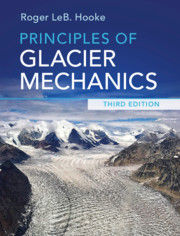Book contents
- Principles of Glacier Mechanics
- Reviews
- Principles of Glacier Mechanics
- Copyright page
- Dedication
- Contents
- Preface to the third edition
- Preface to the second edition
- Preface to the first edition
- Physical constants relevant to ice
- Derived SI units and conversion factors
- 1 Why study glaciers?
- 2 Some basic concepts
- 3 Mass balance
- 4 Flow and fracture of a crystalline material
- 5 The velocity field in a glacier
- 6 Temperature distribution in polar ice sheets
- 7 The coupling between a glacier and its bed
- 8 Water flow in and under glaciers: Geomorphic implications
- 9 Stress and deformation
- 10 Stress and velocity distribution in an idealized glacier
- 11 Numerical modeling
- 12 Applications of stress and deformation principles to classical problems
- 13 Ice streams and ice shelves
- 14 Finite strain and the origin of foliation
- 15 Response of glaciers to climate change
- 16 Ice core studies
- Problems
- References
- Index
12 - Applications of stress and deformation principles to classical problems
Published online by Cambridge University Press: 20 December 2019
- Principles of Glacier Mechanics
- Reviews
- Principles of Glacier Mechanics
- Copyright page
- Dedication
- Contents
- Preface to the third edition
- Preface to the second edition
- Preface to the first edition
- Physical constants relevant to ice
- Derived SI units and conversion factors
- 1 Why study glaciers?
- 2 Some basic concepts
- 3 Mass balance
- 4 Flow and fracture of a crystalline material
- 5 The velocity field in a glacier
- 6 Temperature distribution in polar ice sheets
- 7 The coupling between a glacier and its bed
- 8 Water flow in and under glaciers: Geomorphic implications
- 9 Stress and deformation
- 10 Stress and velocity distribution in an idealized glacier
- 11 Numerical modeling
- 12 Applications of stress and deformation principles to classical problems
- 13 Ice streams and ice shelves
- 14 Finite strain and the origin of foliation
- 15 Response of glaciers to climate change
- 16 Ice core studies
- Problems
- References
- Index
Summary
To develop some facility with application of the principles discussed in the preceding three chapters, some examples of classical problems are discussed in this chapter. The first problem involves the collapse of a cylindrical hole in ice. This solution is applied to problems of determining flow law constants from closure of tunnels and boreholes, ofclosure of water conduits in response to melting by energy dissipated in the flowing water. In the second, force balance calculations are used to study the role of seasonal and shorter-term variations in water pressure on glacier motion.Then, the need to consider longitudinal coupling in calculations of deformation rates is explored. In calculating velocity profiles at a point on a glacier, one needs to take into consideration not only the surface slope and ice thickness at that point, but also their variation up- and downglacier from that point.Finally, the theoretical basis for analysis of borehole deformation data to determine flow law constants is presented. Longitudinal strain rates and vertical advection need to be taken into consideration in analyzing borehole tilt data.
- Type
- Chapter
- Information
- Principles of Glacier Mechanics , pp. 320 - 349Publisher: Cambridge University PressPrint publication year: 2019

